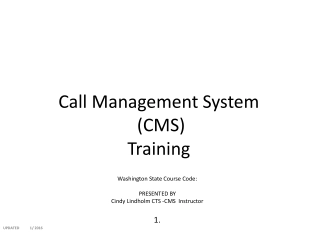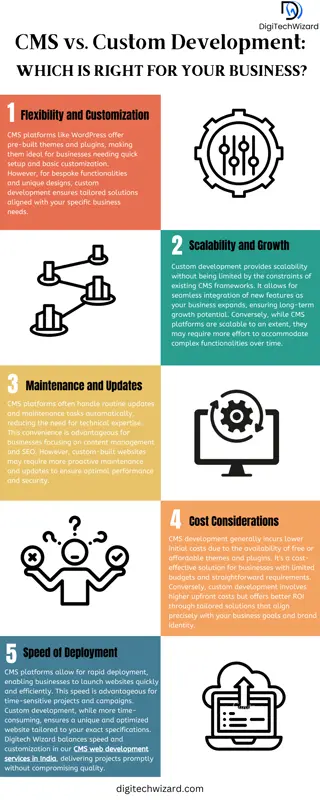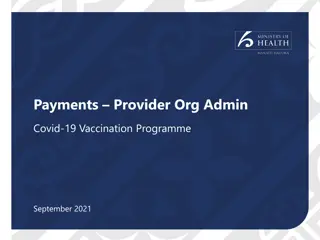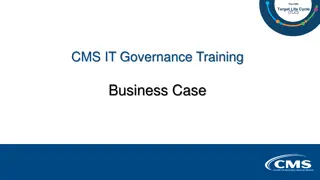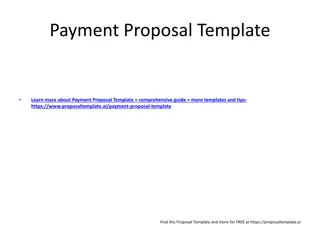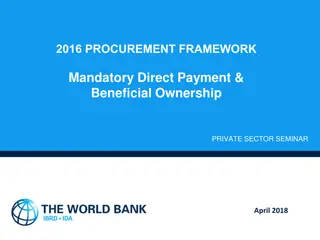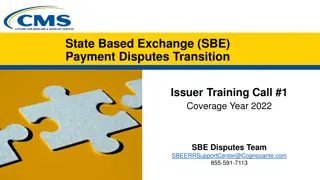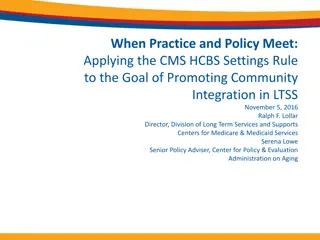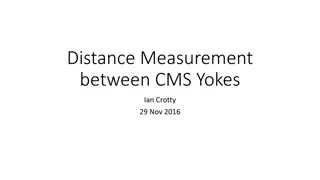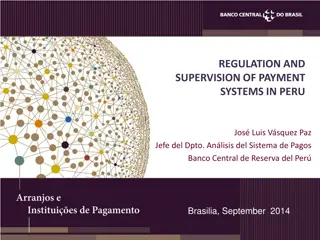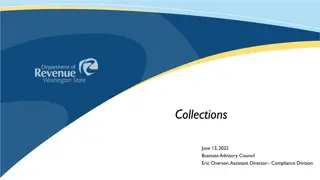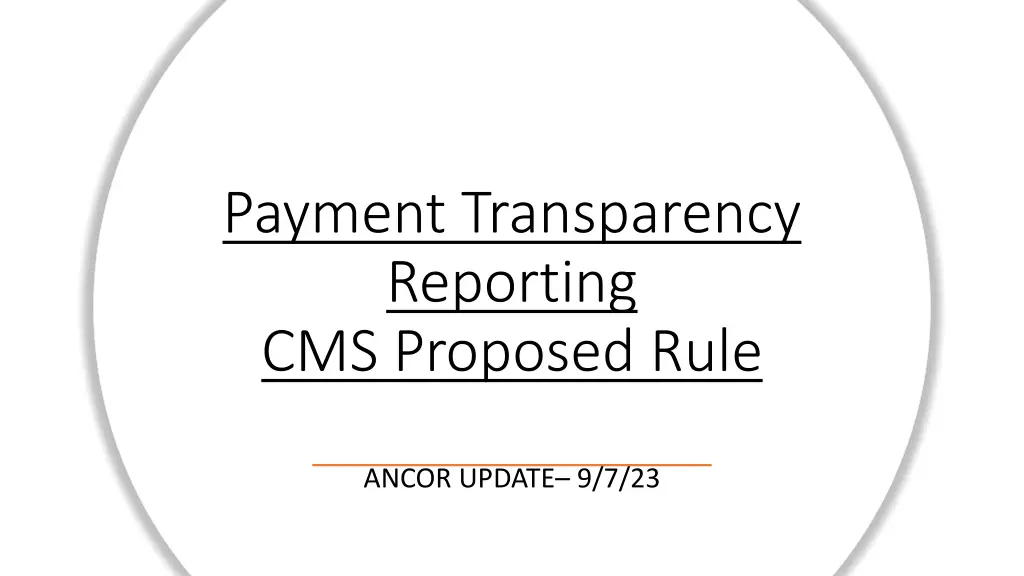
Medicaid Institutional Payment Transparency Reporting Rule Update
Stay informed about the latest CMS proposed rule regarding payment transparency and reporting in the Medicaid institutional payment sector. Learn about the minimum staffing standards for long-term care facilities and the implications for Medicaid payments. This update aims to promote accountability, transparency, and workforce sufficiency in the direct care and support staff sector.
Download Presentation

Please find below an Image/Link to download the presentation.
The content on the website is provided AS IS for your information and personal use only. It may not be sold, licensed, or shared on other websites without obtaining consent from the author. If you encounter any issues during the download, it is possible that the publisher has removed the file from their server.
You are allowed to download the files provided on this website for personal or commercial use, subject to the condition that they are used lawfully. All files are the property of their respective owners.
The content on the website is provided AS IS for your information and personal use only. It may not be sold, licensed, or shared on other websites without obtaining consent from the author.
E N D
Presentation Transcript
Payment Transparency Reporting CMS Proposed Rule ANCOR UPDATE 9/7/23
ICF Community of Practice Overview ICF Community of Practice Overview ANCOR Connected Community: Meetings: 3rdThursday of Each Month on 2pm EST via zoom Consultant: Catherine Thibedeau: cthibedeau@iamsupports.org Than Johnson: than.johnson@gmail.com ANCOR Staff: Lydia Dawson: LDawson@ancor.org
Minimum Staffing Standards for Long-Term Care Facilities and Medicaid Institutional Payment Transparency Reporting Rule Text RULE TEXT CMS Press Release CMS PRESS RELEASE Fact Sheet FACT SHEET PUBLICATION DATE: COMMENTS DUE: 11/6/2023 09/06/2023 09/06/2023 (ICF/IID INCLUSIVE PART BEGINS ON PAGE 95)
Does NOT Apply to ICFs Minimum Nurse Staffing Standards RN On-Site Requirement Facility Assessment Requirement Medicare and Medicaid Programs: Minimum Staffing Standards for Long- Term Care Facilities and Medicaid Institutional Payment Transparency Reporting (CMS 3442- P) Applies to ICFs Institutional payment reporting requirements: Requires states to report to CMS on the percentage of Medicaid payments for services in nursing facilities and intermediate care facilities for individuals with intellectual disabilities that are spent on compensation for direct care workers and support staff. These requirements would apply regardless of whether a state s long- term services and supports delivery system is fee-for-service or managed care. Promote the public availability of Medicaid institutional payment information: Both states and CMS make the institutional payment information available on public-facing websites.
Rationale/Intentions/Goals 1. Promote accountability and transparency. 2. Identify national trends and inform efforts to link sufficient compensation and access to/quality of services. 3. Inform future policies enactment to support the sufficiency of the direct care and support staff workforce. 4. Build on the proposed Access Rule. 5. Hold States accountable that Medicaid payments are sufficient to enlist enough workers so that high quality LTSS are available. 6. Help States understand if current payment rates are consistent with economy, efficiency, and quality, and sufficient to ensure meaningful beneficiary access. 7. Help States identify outliers on direct care worker and support staff compensation. 8. Motivate some facilities to increase staffing due to the transparency requirements 9. Create an incentivized and stable LTSS workforce comprised of workers with the training, expertise, and experience to meet the diverse and often complex needs of individuals, reduce reliance on overtime/costlier temporary staff, and reduce the incidence of emergency department visits and hospitalizations.
Specific Comment Requested Direct Care Worker Definition Support Staff Definition Compensation Definition Reporting Frequency (Annually) Burden of Reporting at Facility Level vs. Aggerate Inclusion of Median Hourly Wage Methodology for Calculating Percentage Adding Reporting of State Average FFS Per Diem Rate Adding a minimum percentage of the payments spent ion for direct care workers and support staff wages (yes/no; what % should it be?) Publication of Data 4 Year Implementation Plan State Website Posting and State Institutional Payment Transparency Reporting Requirements and Burden
Compensation Compensation defined to include: salary, wages, and other remuneration as defined by the Fair Labor Standards Act and implementing regulations (29 U.S.C. 201 et seq., 29 CFR parts 531 and 778) benefits (such as health and dental benefits, sick leave, and tuition reimbursement employer share of payroll taxes for designated workers Does not include training or other costs. Concerned that requesting providers to quantify and include costs of non-financial benefits would prove burdensome and create a lack of uniformity. Comment Sought: 1. Is the proposed definition of compensation adequate? 2. Should the definition of compensation include other specific financial and non-financial forms of compensation for the workers included in these proposed provisions?
Direct Care Worker Direct care workers are individuals employed by or contracted or subcontracted with a Medicaid provider or State or local government agency to include: nurses (registered nurses, licensed practical nurses, nurse practitioners, or clinical nurse specialists) certified nurse aides who provide such services under the supervision of one of the foregoing nurse provider types; licensed physical therapists, occupational therapists, speech-language pathologists, and respiratory therapists; certified physical therapy assistants, occupational therapy assistants, speech-language therapy assistants, and respiratory therapy assistants or technicians; social workers; personal care aides; medication assistants, aides, and technicians; feeding assistants; activities staff; an other individuals who are paid to provide clinical services, behavioral supports, active, or address activities of daily living Intended to broadly define such workers to appropriately capture the diversity of roles and titles that direct care workers may have. Does not include administrators (or staff whose primary function is administrative or supervisory), physicians or physician assistants due to desire to align the definition with the proposed Access Rule, therefore, providing a more consistent picture of the direct care workforce for individuals receiving Medicaid-covered LTSS across settings.
Direct Care Worker Comment Sought: 1. Are there categories of staff who should be add to, or remove from, our proposed definition? 2. Does the definition cover the varied ownership and employment relationships/adequately capture the universe of potential employment or contractual relationships between facilities and relevant direct care workers? For instance, privately owned and operated or facilities owned and operated by a local or State government; facilities that are partially or wholly staffed through a third-party staffing organization through a contractual arrangement; or staff who are employed directly or as independent contractors? We solicit comment on whether this component of our proposed definition. 3. Does the definition include staff who can be instrumental in helping residents achieve the level of health or develop skills needed to transition from nursing facilities back into the community, assess residents for readiness for transition, and support in discharge planning. We request feedback from the public as to whether our proposed definition appropriately includes workers who provide these services, or if we would need to include such staff as a distinct category of staff within this provision. 4. should the definition of direct care staff at 483.70(q)(1) be used instead? If so, does that definition include the staff who help residents achieve the level of health or develop the skills needed to transition from nursing facilities back into the community, assess residents for readiness for transition, and support in discharge planning, or if these staff would still need to be specified as a separate category.
Support Staff Support staff are facility employed and those contracted and subcontracted (For instance, a facility may contract with a third-party transportation company to provide transportation services to residents.) defined to include: housekeepers; janitors and environmental services workers; groundskeepers; food service and dietary workers; drivers responsible for transporting residents; and any other individuals who are not direct care workers and who maintain the physical environment of the care facility or support other services Comment Sought: 1. Are there other specific types of workers, such as security guards, who should be included in the definition? 2. Are there any of the types of workers listed in this proposal should be excluded from the definition of support staff? 3. Should support staff be included in this proposed reporting requirement? 4. Should support staff to include individuals employed by or contracted or subcontracted? Does this adequately capture the universe of potential employment or contractual relationships between facilities and relevant support staff?
Annual Reporting Proposing reporting be annually. Comment Sought: 1. Is annual reporting is reasonable or should the frequency of reporting be every other year or every 3 years? Why?
Median Hourly Wage Considering adding reporting requirements for States to report on median hourly compensation for direct care workers and median hourly compensation for support staff, in addition to the percent of Medicaid payments going to overall compensation for these workers. Comment Sought: 1. Is reporting on median compensation useful information? 2. If so, should it be on salary/wages, or on total compensation (salary/wages and other remuneration, including employer expenditures for benefits and payroll taxes)? 3. Should it be calculated for all direct care workers and for all support staff, or further broken down by the staff categories specified?
Facility Level Reporting States and providers should be able to obtain the information needed to calculate the percent of Medicaid payments made to direct care workers and support staff using: data used in rate setting internal wage information cost reports resident census numbers Comment Sought: 1. Should information be reported at the facility level? 2. Are there concerns about the potential burden on providers and States?
Methodology Development Should proposed rule to be finalized, a consistent methodology for States to follow for collecting and reporting information from facilities will be developed/submitted for public comment. Comment Sought: 1. What are suggestions for an appropriate methodology for identifying the percentage of Medicaid payment that has gone to direct care worker and support staff compensation (noting this pending rule finalization)? 2. Are separate methodologies recommended for base payments and supplemental payments needed, and if so, suggestions for each? 3. What are suggestions for a methodology to report median hourly wages, if supported?
Average Statewide Per Diem Rate Reporting Considering add that States make public information the average statewide FFS per diem rate. This could make the percentage of compensation data more meaningful if had the underlying rates to add context. Comment Sought: 1. Should the average statewide FFS per diem rate (one reported rate for nursing facility services and one reported rate for ICF/IID services.) be added to the reporting requirements? 2. The average per diem base payment rate would provide an average that is more representative of the typical per diem rate? On the other hand, an average that includes both the per diem base payment rate and supplemental payments would provide a more complete picture of the total Medicaid spending on these services. Which option would provide the most useful snapshot of payment for these services?
Minimum percentage of the payments spent on Minimum percentage of the payments spent on compensation for direct care workers and support staff compensation for direct care workers and support staff In the future, considering adding requirement that a minimum percentage of all Medicaid payments, including but not limited to base payments and supplemental payments, be spent on compensation to direct care workers and support staff. Currently, do not have adequate information at this time to determine what the minimum percentage should be. Comment Sought: 1. For future rulemaking, should a minimum percentage of the be required to be spent on compensation for direct care workers and support staff? 2. Is such requirement necessary to ensure that payment rates and methodologies are economic and efficient and consistent with meaningful beneficiary access to safe, high -quality care, or otherwise necessary for the proper and efficient operation of the State plan? 3. What should the specific minimum percentage required to be spent on compensation to direct care workers and support staff be? Provide data or evidence to support such recommendations.
Implementation Plan Proposing 4 years (For MCO s or PIHP s contract, the first managed care plan contract rating period that begins 4 years after the effective date of the final rule) to implement reporting requirements to allow States time to complete any necessary work to amend State regulations, policies, operational processes, information systems, and contracts needed. Comment Sought: 1. Is this timeframe sufficient? Should require a shorter or longer timeframe (such as 3 or 5 years)? 2. If a shorter or longer timeframe is recommended, the rationale for that shorter or longer timeframe.
Advisory Group For future rulemaking, considering requiring States to implement an interested parties advisory group in parallel with proposed requirements Access proposed rule. Comment Sought: 1. For future rulemaking, should States be required to establish an interested parties advisory group to advise and consult on the sufficiency of FFS rates paid to direct care workers?
Publicizing Information States shall include prominent language on the website explaining that assistance in accessing the required information on the website is available at no cost to the public and include information on the availability of oral interpretation in all languages and written translation available in each non-English language, how to request auxiliary aids and services, and a toll-free and TTY/TDY telephone number. Also, proposing CMS must report on Medicaid.gov or a successor website the information reported by States. 1. Are these requirements sufficient to ensure the accessibility of the information for people receiving services and other interested parties?
Publicizing Information States are required to provide data on one website, either directly or by linking to relevant information on the websites of the managed care plan that is contracted to cover nursing facility or IFC/IID services. 1. Should States be permitted to link to websites of these managed care plans, and if so, should the number of separate websites that a State could link to in place of directly reporting the information on its own website be limited? 2. Or, should all the required information be posted directly on a website maintained by the State?
Submit Comments Electronically: Federal Register :: Medicare and Medicaid Programs; Minimum Staffing Standards for Long- Term Care Facilities and Medicaid Institutional Payment Transparency Reporting Snail mail: Centers for Medicare & Medicaid Services Department of Health and Human Services Attention: CMS 3442 P P.O. Box 8016 Baltimore, MD 21244 8016

